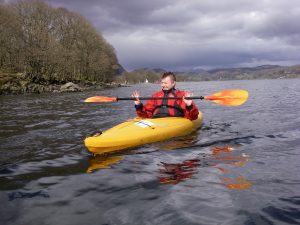It’s about this time of year we get enquiries from people who want find out about kayaks and canoes. Increasingly we are also getting people interested using kayaks and canoes on one of the “Canoe Trails” like The Great Glen in Scotland, Windermere in The Lake District, or the more humble trail starting at Tewitfield on The Lancaster Canal. So whatever has brought you to this page I hope that the information below may answer some of your questions and give you some insight into the possibilities for your adventure.
To kayak or canoe that is the question.
So first up which is which? Well kayaks use a paddle with a blade at each end and you sit on or in your boat. Single seater kayaks are most common and of those sit on top kayaks (SOT) are very common.

With canoes you have a single blade paddle. The style of boat most common is the traditional Open Boat or Canadian Canoe. These come with seats but actually are best paddled from a kneeling position.

Learning to paddle kayak or canoe
You should never go on the water without a buoyancy aid or life jacket. Suitable clothing to keep you warm is also essential and you need to have sufficient experience and knowledge to know what suitable clothing is. Getting help and instruction form a suitably qualified instructor is the best way forward and time spent doing this will mean that your progress is quicker, more enjoyable and almost certainly safer.
People who come to us having had quite a few trips out on or in kayaks or canoes, and considering themselves not beginners, are always surprised at how much we teach them and what they learn even in the space of a day. Instruction can really help open up a whole new world of experience. One very important aspect of developing good skills and technique is that often have limited flexibility and mobility can get away with using upper body strength to propel themselves in their boats. Children and women often have the advantage that they are more mobile and flexible but don’t have as much strength. Even with just a little instruction, techniques can be taught meaning that a lack of strength, flexibility or mobility no longer present an impassable barrier to enjoyment and progress in the activity.
Long distance canoe trials; a walk in the park?
So most of us started walking in the park at around the age of 1 year, but before that we learnt to crawl. I doubt you were taught to crawl or walk but most of us would have been under the watchful eye of a grown up. And yes we fell over but the grown up was usually there to help and guide so we got better safely. What’s important to remember is that like walking, kayaking and canoeing require good posture, balance and involve coordinated movements in order to progress through the water without falling over (or capsizing as it is called if you fall over in the lake). The movements, use of muscles and balance for kayaking are not the same as for walking and so need to be learnt.
So this is my message to you. Don’t feel embarrassed or self conscious about wanting a guide or leader. Don’t use the excuse that you learn better on your own and you think that discovering things for yourself will be better. All British Canoeing Instructors are now encouraged to take a paddler centred approach to teaching and learning. A good instructor will help you explore and develop skills in a way which best suits you and moves you on to becoming an independent paddler.
